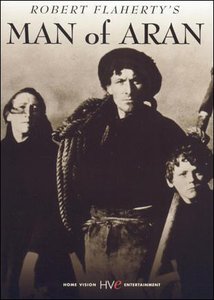Man of Aran
| Man of Aran | |
|---|---|
 |
|
| Directed by | Robert J. Flaherty |
| Produced by | Michael Balcon |
| Written by | Robert J. Flaherty |
| Starring | Colman 'Tiger' King Maggie Dirrane Michael Dillane |
| Music by | John D. H. Greenwood |
| Cinematography | Robert J. Flaherty |
| Edited by | John Goldman |
|
Production
company |
|
| Distributed by | Gaumont British Distributors |
|
Release date
|
|
|
Running time
|
76 minutes |
| Country | Ireland; Irish Free State |
| Language | Irish, English |
Man of Aran is a 1934 Irish fictional documentary (ethnofiction) film directed by Robert J. Flaherty about life on the Aran Islands off the western coast of Ireland. It portrays characters living in premodern conditions, documenting their daily routines such as fishing off high cliffs, farming potatoes where there is little soil, and hunting for huge basking sharks to get liver oil for lamps. Some situations are fabricated, such as one scene in which the shark fishermen are almost lost at sea in a sudden gale. Additionally, the family members shown are not actually related, having been chosen from among the islanders for their photogenic qualities.
George Stoney's 1978 documentary How the Myth was Made, which is included in the special features of the DVD, relates that the Aran Islanders had not hunted sharks in this way for over fifty years at the time the film was made. Man of Aran is Flaherty's re-creation of culture on the edges of modern society, even though much of the primitive life depicted had been left behind by the 1930s. It is impressive, however, for its drama, for its spectacular cinematography of landscape and seascape, and for its concise editing.
The film opens with a boy crab fishing. We then observe three fishermen landing a flimsy holed curragh in the force of the wind and the huge waves. Next we see some of the hardships of mundane Aran life: making a field on the barren rocks using seaweed and soil scraped out of rock crevices, fixing holes in the boat with a mixture of cloth and tar, rendering the liver of the giant basking shark. The film follows as the men of Aran harpoon the huge beasts from their bád iomartha (a wooden carvel hulled craft), the film ends with another storm sequence where the distressed family on shore watch the prolonged struggle of the boat to land safely against the elements.
The reputation of Man of Aran rests as much on controversies over truth and accuracy than its aesthetic achievement. Some contend that Man of Aran is more valuable as a documentary of Robert Flaherty’s vision of life than it is of life itself. Others see it as a betrayal of documentary’s mission, “to tell it like it is”. And yet, according to Richard Barsam, Flaherty is one of the great innovators of the documentary form…creating a nonfiction genre all of his own.
According to anthropologist John Messenger there are over one hundred factual errors in the film. Among the most notable is the shark hunting sequence, which dominates the latter half of the story. Kimball says this practice had disappeared so long ago that the islanders didn't know how to make or use the harpoons and had to be taught the skills of the hunt. Messenger who visited Islands between 1958 and 1968 goes further, claiming that the Islanders had never engaged in shark hunting then, or at any time in the past. Flaherty brought fisherman from Scotland to teach the locals how it is done. “Flaherty…created new customs, such as shark fishing, and seriously distorted numerous indigenous ones in order to make the Man of Aran fit his preconceptions and titillate the camera.” Flaherty himself admits the shark fishing sequence was needed for the box-office.
...
Wikipedia
